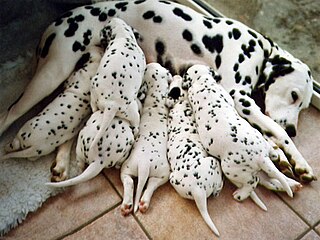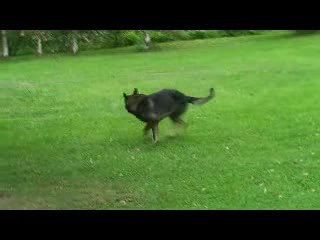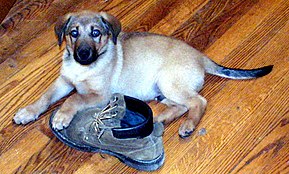Neutering, from the Latin neuter, is the removal of a non-human animal's reproductive organ, either all of it or a considerably large part. The male-specific term is castration, while spaying is usually reserved for female animals. Colloquially, both terms are often referred to as fixing. In male horses, castrating is referred to as gelding. An animal that has not been neutered is sometimes referred to as entire or intact.
Dog intelligence or dog cognition is the process in dogs of acquiring information and conceptual skills, and storing them in memory, retrieving, combining and comparing them, and using them in new situations.

Dog communication is the transfer of information between dogs, as well as between dogs and humans. Behaviors associated with dog communication are categorized into visual and vocal. Visual communication includes mouth shape and head position, licking and sniffing, ear and tail positioning, eye gaze, facial expression, and body posture. Dog vocalizations, or auditory communication, can include barks, growls, howls, whines and whimpers, screams, pants and sighs. Dogs also communicate via gustatory communication, utilizing scent and pheromones.

Dog aggression expressed by dogs is considered to be normal behaviour and various types of aggression are influenced by a dog's environment and genetic predisposition. Dogs commonly display possessive aggression when defending resources or themselves.

Feather-plucking, sometimes termed feather-picking, feather damaging behaviour or pterotillomania, is a maladaptive, behavioural disorder commonly seen in captive birds that chew, bite or pluck their own feathers with their beak, resulting in damage to the feathers and occasionally the skin. It is especially common among parrots, with an estimated 10% of captive parrots exhibiting the disorder. The areas of the body that are mainly pecked or plucked are the more accessible regions such as the neck, chest, flank, inner thigh and ventral wing area. Contour and down feathers are generally identified as the main target, although in some cases, tail and flight feathers are affected. Although feather-plucking shares characteristics with feather pecking commonly seen in commercial poultry, the two behaviours are currently considered to be distinct as in the latter, the birds peck at and pull out the feathers of other individuals.
Skin disorders are among the most common health problems in dogs, and have many causes. The condition of a dog's skin and coat is also an important indicator of its general health. Skin disorders of dogs vary from acute, self-limiting problems to chronic or long-lasting problems requiring life-time treatment. Skin disorders may be primary or secondary in nature, making diagnosis complicated.

Clomipramine, sold under the brand name Anafranil among others, is a tricyclic antidepressant (TCA). It is used in the treatment of various conditions, most-notably obsessive–compulsive disorder but also many other disorders, including panic disorder, major depressive disorder, trichotilomania, body dysmorphic disorder and chronic pain. It has also been notably used to treat premature ejaculation and the cataplexy associated with narcolepsy.

The health of dogs is a well studied area in veterinary medicine.

A lick granuloma, also known as acral lick dermatitis, is a skin disorder found most commonly in dogs, but also in cats. In dogs, it results typically from the dog's urge to lick the lower portion of one of their legs.

The dog is a domesticated descendant of the wolf. Also called the domestic dog, it is derived from extinct gray wolves, and the gray wolf is the dog's closest living relative. The dog was the first species to be domesticated by humans. Experts estimate that hunter-gatherers domesticated dogs more than 15,000 years ago, which was before the development of agriculture. Due to their long association with humans, dogs have expanded to a large number of domestic individuals and gained the ability to thrive on a starch-rich diet that would be inadequate for other canids.

Dog behavior is the internally coordinated responses of individuals or groups of domestic dogs to internal and external stimuli. It has been shaped by millennia of contact with humans and their lifestyles. As a result of this physical and social evolution, dogs have acquired the ability to understand and communicate with humans. Behavioral scientists have uncovered a wide range of social-cognitive abilities in domestic dogs.
Cynophobia is the fear of dogs and canines in general. Cynophobia is classified as a specific phobia, under the subtype "animal phobias". According to Timothy O. Rentz of the Laboratory for the Study of Anxiety Disorders at the University of Texas, animal phobias are among the most common of the specific phobias and 36% of patients who seek treatment report being afraid of dogs or afraid of cats. Although ophidiophobia or arachnophobia are more common animal phobias, cynophobia is especially debilitating because of the high prevalence of dogs and the general ignorance of dog owners to the phobia. The Diagnostic and Statistical Manual of Mental Disorders (DSM-IV-TR) reports that only 12% to 30% of those with a specific phobia will seek treatment.
Animal psychopathology is the study of mental or behavioral disorders in non-human animals.

Cancer is the leading cause of death in dogs. It is estimated that 1 in 3 domestic dogs will develop cancer, which is the same incidence of cancer among humans. Dogs can develop a variety of cancers and most are very similar to those found in humans. Dogs can develop carcinomas of epithelial cells and organs, sarcomas of connective tissues and bones, and lymphomas or leukemias of the circulatory system. Selective breeding of dogs has led certain pure-bred breeds to be at high-risk for specific kinds of cancer.
Dog noise phobia, along with dog noise anxiety, are terms sometimes used by dog owners and veterinarians to describe canine fear of, and the corresponding stress responses to, loud noises.

Dog appeasing pheromone (DAP), sometimes known as apasine, is a mixture of esters of fatty acids released by the sebaceous glands in the inter-mammary sulcus of lactating female dogs. It is secreted from between three and four days after parturition and two to five days after weaning. DAP is believed to be detected by the vomeronasal organ and has an appeasing effect on both adults and pups, and assists in establishing a bond with the mother.

Human–canine bonding is the relationship between dogs and humans. This relationship can be traced back to at least 15,000 years ago, to the Bonn-Oberkassel dog, who was found buried alongside two humans. For centuries, dogs have been considered man's best friend. This is most evident in western countries, such as the United States, where over 48% of households have a pet dog.
The body language of dogs is one form of non-verbal communication whereby dogs can express emotions and intentions through bodily movements. It refers to the interpretation of posture and behaviour of species in the genus Canis. This form of visual communication is generally used for identifying emotions and intentions of domestic dogs, though it can also be applied to wild canines such as wolves. Understanding the body language of dogs is particularly important in preventing dog bites, especially of children. This communication can occur between dogs, or during a dog-human interaction. Such movements primarily involve the tail, the ears, and the head/body. Tail-wagging is a common tail movement used by dogs to communicate. Additionally, ear flattening or heightening are typical movements made using the ears. In terms of the head/body, it is of interest to study turning of the head, as well as the overall posture of the dog.

Tail chasing is a behaviour exhibited in dogs that is characterized by spinning in tight circles in either direction, and can be slow and focused on the tail or fast and unfocused. It is a compulsion similar to those seen in humans suffering from OCD and it can be quite disruptive to the lives of the dogs themselves, as well as their owners. Some causes have been suggested, including genetic factors, and environmental factors that vary depending on the individual dog. Furthermore, treatment options include drugs that decrease the frequency of tail chasing by targeting the underlying mechanisms, and behavioural changes regulated by the dog's owners.

Fly biting refers to a type of dog behavior: episodes of intentional focused biting at the air, as if the dog is biting at imaginary flies. Cavalier King Charles Spaniels appear to be predisposed to fly catching syndrome, though it has been documented in many different breeds and mixes. Age of onset is varied.















